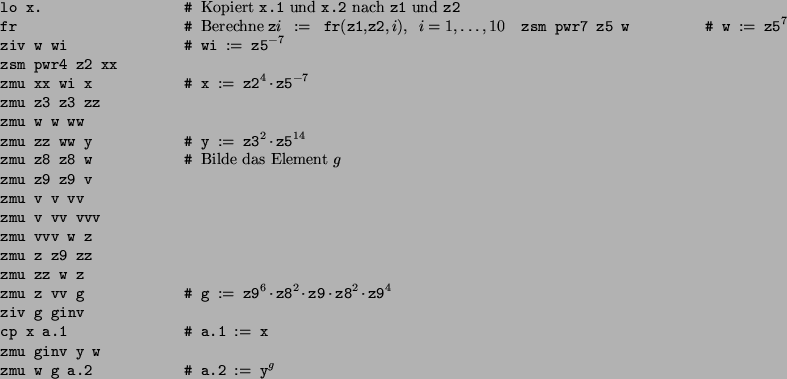Für
![]() ist nach [O'N96, Lemma 5.3 und Lemma
5.5, Seite 447]
ist nach [O'N96, Lemma 5.3 und Lemma
5.5, Seite 447]
Sei
![]() . Dann hat
. Dann hat ![]() neun
Bahnen auf den Punkten
neun
Bahnen auf den Punkten
![]() . Wird die Operation von
. Wird die Operation von
![]() auf die Bahn mit der Länge von 120 Punkten
eingeschränkt, so erhält man eine Gruppe, die isomorph zu
auf die Bahn mit der Länge von 120 Punkten
eingeschränkt, so erhält man eine Gruppe, die isomorph zu ![]() ist.
ist.
Mit MeatAxe wird das Erzeugnis von x.1![]() ,
x.2
,
x.2![]() auf die Bahn der Länge 120 eingeschränkt, indem
sukzessive die Operation auf einer Bahn (s-
auf die Bahn der Länge 120 eingeschränkt, indem
sukzessive die Operation auf einer Bahn (s- ![]() .)
und dem Rest (q-
.)
und dem Rest (q- ![]() .) ausgerechnet wird:
.) ausgerechnet wird:

bis durch s- ![]() .1, s-
.1, s- ![]() .2 eine
Operation auf 120 Punkten beschrieben wird. Bezeichne mit
.2 eine
Operation auf 120 Punkten beschrieben wird. Bezeichne mit ![]() das auf die Bahn der Länge 120 eingeschränkte Element
das auf die Bahn der Länge 120 eingeschränkte Element ![]() . Seien
. Seien
![]() und
und
![]() . Dann kann man
nachrechnen, daß
. Dann kann man
nachrechnen, daß
![]() . Betrachte die Elemente
. Betrachte die Elemente
![]() als Worte in den Erzeugern
als Worte in den Erzeugern ![]() :
:
Die Berechnung mit GAP ergibt, daß
![]() für
für
![]() und
und
![]() ist eine
Gruppe von Ordnung 720 mit (nichttrivialen) Normalteilern der Ordnung
2 und 360.
ist eine
Gruppe von Ordnung 720 mit (nichttrivialen) Normalteilern der Ordnung
2 und 360.
![]() ist ein Element der Ordnung 2 das zentral in
ist ein Element der Ordnung 2 das zentral in ![]() liegt. In GAP läßt sich nun nachrechnen, daß
liegt. In GAP läßt sich nun nachrechnen, daß
![]() und für
und für
![]() und
und
![]() ist
ist
![]() eine einfache Gruppe der Ordnung
360. Also ist
eine einfache Gruppe der Ordnung
360. Also ist
Das folgende Script berechnet a.1![]() und a.2
und a.2![]() mit der MeatAxe:
mit der MeatAxe:
